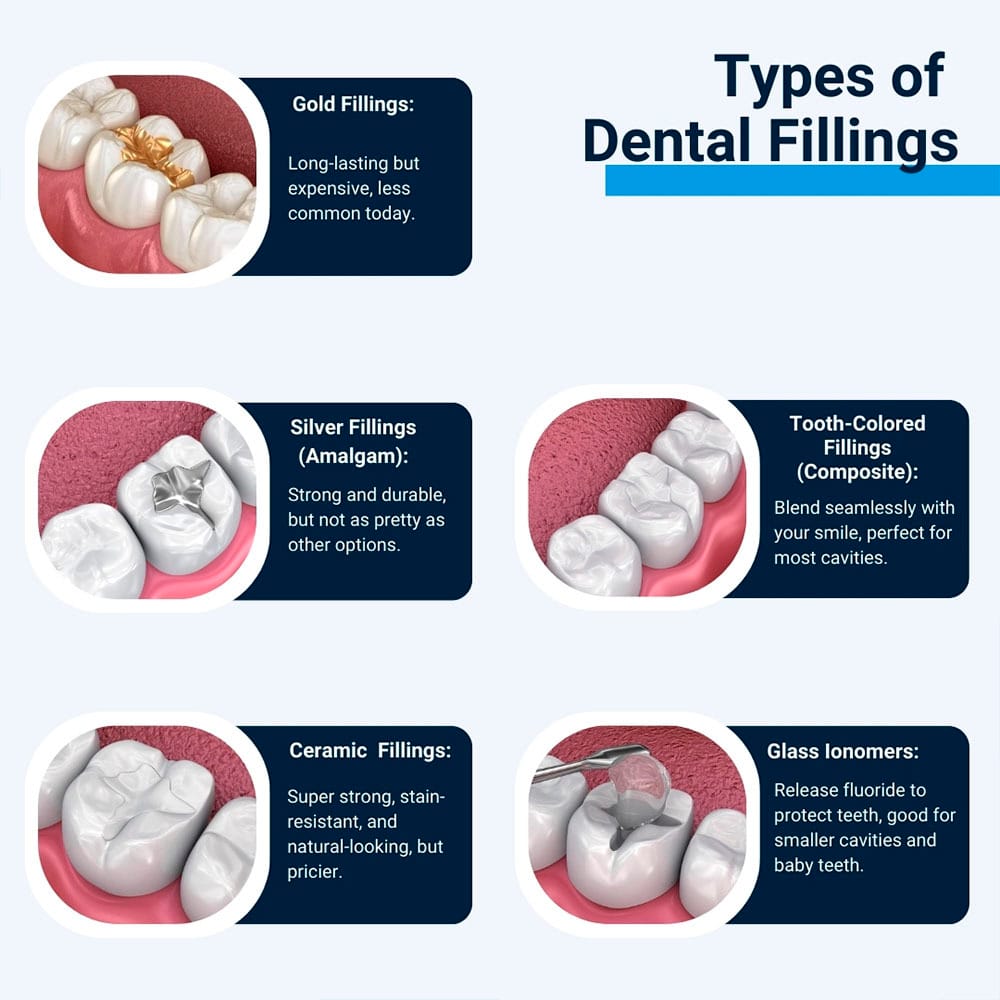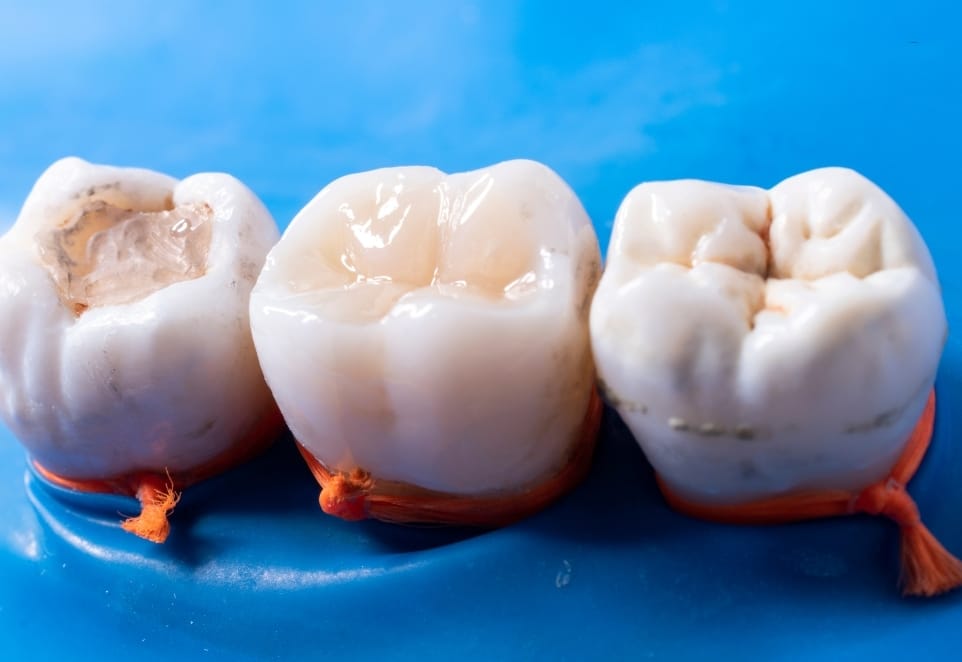What Is a Dental Filling?
A dental filling restores a tooth that has become damaged in some way, where part of its original structure is missing. The filling replaces the missing structure, restoring strength to the tooth and ensuring you can bite and chew food without any pain or discomfort. The filling also restores the appearance of a tooth.
When Would I Need a Dental Filling?
Dental fillings are useful in various situations. We may recommend this restorative dental treatment if tooth decay has caused a cavity. Dental fillings can also be used to repair small chips and cracks in teeth.
A tooth requiring a dental filling can often feel slightly more sensitive to temperature changes or look visibly damaged. If you think you need a filling, please get in touch with us quickly. Repairing a tooth with a small filling can avoid further damage that may require more expensive and lengthier treatment.

What Can Dental Fillings Be Made from?
Two different types of fillings are available: direct and indirect.
Direct Fillings
These fillings are placed chairside, so after we prepare the tooth, we can insert the filling material immediately, completing your treatment during a single visit. Direct fillings can be made from materials that include:
- Composite resin
- Glass ionomer
- Amalgam
Composite Resin
Tooth-colored composite resin is suitable for small to medium-sized cavities. It comes in many shades, so we can closely match the color to your natural tooth, creating a virtually invisible restoration. Composite resin can be an excellent choice for a front tooth filling where aesthetics are important.
We frequently recommend composite resin because it is a biomimetic material that works harmoniously with your natural tooth structure. It doesn’t flex or change shape during temperature changes or when under pressure and bonds strongly to your tooth, sealing the cavity and preventing further infection and decay.
Glass Ionomer
Glass ionomer is made from a special type of glass powder, and it is designed to release fluoride slowly.
This filling material is used less often because it is more fragile than composite resin and typically only lasts a few years before it needs replacing. Therefore, it tends to be used to protect decayed tooth roots rather than biting and chewing surfaces that require a strong restoration.
We would most likely recommend this filling for children because of the fluoride content.
Amalgam
Amalgam cavity fillings have been used for over 100 years and consist of several different metals, but they are less popular nowadays and have been largely replaced by more modern materials like composite resin. Although hard wearing, amalgam is very visible in the mouth, and the metal can discolor over time.
Indirect Fillings
An indirect filling is made outside of the mouth, so after our dentist prepares your tooth, they take a digital dental impression to create your new restoration. You may require a second appointment to have the filling fitted. This type of filling is also called an inlay or onlay.
An inlay restores the chewing surface of a tooth. An onlay is larger and can restore the chewing surface in addition to one or more tooth cusps. Indirect fillings can be made from the following materials:
- Porcelain
- Gold alloy
Porcelain
Porcelain fillings are beautiful, strong, and long-lasting. Porcelain is another biomimetic material like composite resin, although these fillings are more expensive. We may be able to provide same-day fillings using CADCAM technology to mill your porcelain filling while you wait. This eliminates the need for a second appointment.
Gold Alloy
Gold alloy fillings are made from a combination of metals and are highly polished. Gold is a good material for filling teeth because it is long-lasting, hard-wearing, and will not damage the opposing teeth.
Gold fillings must be made in a dental lab, so you will need a second appointment to have the filling fitted and bonded in place once it is ready.
The Process for a Dental Filling
Having a dental filling is straightforward. The steps for a direct filling are described below.
- We ensure your tooth is numb using local anesthetic before our dentist prepares it, removing all the damage and infection.
- Once your tooth is prepared, we can insert a filling material like composite resin and harden it with blue light.
- When all the filling material is in place, our dentist carefully shapes and polishes it and checks your bite to ensure it isn’t too high.
The Process for an Indirect Filling
If you have an indirect filling, we will need to take a digital dental impression of your tooth after it is prepared. If you require a second appointment, we will place a temporary filling material into the tooth to protect it.
The temporary filling is removed and your permanent filling can be inserted and bonded in place during your second appointment.
What to Expect After You Have a Dental Filling
Immediately after treatment, you may notice that your tooth feels slightly more sensitive for the first few days. It should soon return to normal. If your tooth continues to feel sensitive or painful, please get in touch with us.
Sometimes, a filling can be slightly too high after treatment. In this case, we can soon adjust it to make it feel more comfortable. Occasionally, a tooth can feel more sensitive because the dental pulp is inflamed, and root canal therapy might be needed.
What Are the Benefits of Dental Fillings?
The benefits of having this restorative dental treatment can include:
- Protecting and preserving your tooth and getting rid of infection so it is pain-free.
- Treatment is affordable and quick to complete.
- Tooth-coloured fillings are nearly invisible and look beautiful.
How Long Should My Filling Last?
Some filling materials are more durable than others, but the longevity of your filling also depends on your oral care.
Generally, you can expect a composite resin filling to last five years or more. As it ages, it can start to stain. Porcelain and gold fillings last much longer, typically 10 or 15 years or more, but these are more expensive than composite resin. Amalgam fillings also last a long time, usually at least 10 years.
Looking after Your Dental Filling
Eventually, you will need to have your dental filling replaced. However, properly caring for it can help it to last longer.
- Ensure you brush twice daily and floss every day.
- Try to avoid biting or chewing very hard foods like ice cubes.
- Avoid biting your nails or using your teeth as tools.
- Wear a custom night splint if you have a teeth-grinding and clenching habit (bruxism).
We will check the condition of all restorations during your regular dental exams and can recommend when it’s time to renew them.
How Much Is a Dental Filling?
The cost of your dental filling depends on the size and the material chosen. Small to medium-sized fillings made from composite resin are very affordable.
Larger fillings made from porcelain or gold alloy will cost more but last longer. These filling materials are more expensive, and the process to make and fit them is longer.
We can advise you on how much your filling will cost during your initial consultation.
Will Dental Insurance Cover the Cost of My Filling?
Dental fillings are a restorative treatment that is necessary to protect and preserve natural teeth. Your dental insurance should cover at least part of the cost. We can advise you on the percentage covered when you visit us.

